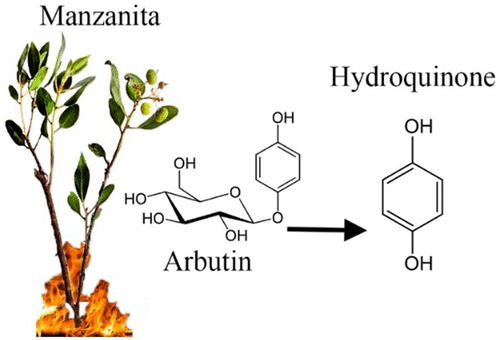当前位置:
X-MOL 学术
›
Environ. Sci. Technol. Lett.
›
论文详情
Our official English website, www.x-mol.net, welcomes your
feedback! (Note: you will need to create a separate account there.)
High Hydroquinone Emissions from Burning Manzanita
Environmental Science & Technology Letters ( IF 8.9 ) Pub Date : 2018-05-15 , DOI: 10.1021/acs.estlett.8b00222 Coty N. Jen 1 , Yutong Liang 1 , Lindsay E. Hatch 2 , Nathan M. Kreisberg 3 , Christos Stamatis 2 , Kasper Kristensen 1 , John J. Battles 1 , Scott L. Stephens 1 , Robert A. York 1 , Kelley C. Barsanti 2 , Allen H. Goldstein 1, 4
Environmental Science & Technology Letters ( IF 8.9 ) Pub Date : 2018-05-15 , DOI: 10.1021/acs.estlett.8b00222 Coty N. Jen 1 , Yutong Liang 1 , Lindsay E. Hatch 2 , Nathan M. Kreisberg 3 , Christos Stamatis 2 , Kasper Kristensen 1 , John J. Battles 1 , Scott L. Stephens 1 , Robert A. York 1 , Kelley C. Barsanti 2 , Allen H. Goldstein 1, 4
Affiliation

|
California wildfires are becoming larger and more frequent because of climate change and historical fire suppression. The 2017 fire season was record-breaking in terms of monetary damage, area burned, and human casualties. In addition, roughly 20 million people were exposed to dense wildfire smoke for days. Understanding the health impacts of wildfire smoke requires detailed chemical speciation of smoke produced from different fuels. This study demonstrates the unique chemical fingerprint observed in smoke from burning manzanita, a common chaparral and forest understory shrub found in several ecosystems of California. Burning manzanita during the FIREX Fire Laboratory experiments emitted hydroquinone (1,4-dihydroxybenzene with an emission factor of 0.4 g/kg) and two sterol/triterpenoid tracer compounds at levels up to 100 times higher than those of the other common wildland fuels in California such as pine trees, other shrubs, grasses, and duff. Additionally, these compounds were detected in Berkeley, CA, from smoke produced during the October 2017 wildfires in northern California, a region where manzanita grows. In contrast, the identified fingerprint for manzanita burning emissions was not observed during prescribed fires of a mixed conifer forest in California’s Sierra Nevada, indicating negligible amounts of manzanita were burned. As confirmed by shrub inventory data collected prior to the burns, small amounts of manzanita remain after prescribed burning, a low-severity forest management technique, but larger amounts can occur after recovery from high-severity events like wildfires. Results from this study show that chemical signatures in smoke can be traced back to specific fuels like manzanita and that forest management techniques can be used to limit certain types of wildfire emissions.
中文翻译:

燃烧Manzanita产生的高氢醌排放量
由于气候变化和历史上的灭火,加州的野火正变得越来越大,越来越频繁。就金钱损失,烧毁面积和人员伤亡而言,2017年火灾季节创历史新高。此外,大约有2000万人连续数天暴露于浓烈的野火烟雾中。要了解野火烟雾对健康的影响,就需要对使用不同燃料产生的烟雾进行详细的化学形态分析。这项研究表明,在燃烧的曼萨尼塔烟中观察到了独特的化学指纹,曼萨尼塔塔是加利福尼亚州几种生态系统中常见的丛林和林下灌木丛。在FIREX消防实验室实验中燃烧manzanita释放出对苯二酚(1,4-二羟基苯,排放因子为0。4 g / kg)和两种固醇/三萜类示踪剂化合物,其含量比加利福尼亚州其他常见的野外燃料(例如松树,其他灌木,草和达芙)高100倍。此外,在加利福尼亚州伯克利市,是从2017年10月在加利福尼亚北部(曼萨尼塔生长的地区)发生的野火期间产生的烟雾中检测到这些化合物的。相比之下,在加利福尼亚内华达山脉的针叶林混交林规定的火灾中,未观察到识别出的曼萨尼塔燃烧排放指纹,这表明可燃烧的曼萨尼塔数量可忽略不计。如在燃烧前收集的灌木清单数据所证实的,规定的燃烧后仍残留少量的manzanita,这是一种低强度的森林管理技术,但从高强度的事件(如野火)中恢复后,可能会发生大量的manzanita。
更新日期:2018-05-15
中文翻译:

燃烧Manzanita产生的高氢醌排放量
由于气候变化和历史上的灭火,加州的野火正变得越来越大,越来越频繁。就金钱损失,烧毁面积和人员伤亡而言,2017年火灾季节创历史新高。此外,大约有2000万人连续数天暴露于浓烈的野火烟雾中。要了解野火烟雾对健康的影响,就需要对使用不同燃料产生的烟雾进行详细的化学形态分析。这项研究表明,在燃烧的曼萨尼塔烟中观察到了独特的化学指纹,曼萨尼塔塔是加利福尼亚州几种生态系统中常见的丛林和林下灌木丛。在FIREX消防实验室实验中燃烧manzanita释放出对苯二酚(1,4-二羟基苯,排放因子为0。4 g / kg)和两种固醇/三萜类示踪剂化合物,其含量比加利福尼亚州其他常见的野外燃料(例如松树,其他灌木,草和达芙)高100倍。此外,在加利福尼亚州伯克利市,是从2017年10月在加利福尼亚北部(曼萨尼塔生长的地区)发生的野火期间产生的烟雾中检测到这些化合物的。相比之下,在加利福尼亚内华达山脉的针叶林混交林规定的火灾中,未观察到识别出的曼萨尼塔燃烧排放指纹,这表明可燃烧的曼萨尼塔数量可忽略不计。如在燃烧前收集的灌木清单数据所证实的,规定的燃烧后仍残留少量的manzanita,这是一种低强度的森林管理技术,但从高强度的事件(如野火)中恢复后,可能会发生大量的manzanita。











































 京公网安备 11010802027423号
京公网安备 11010802027423号